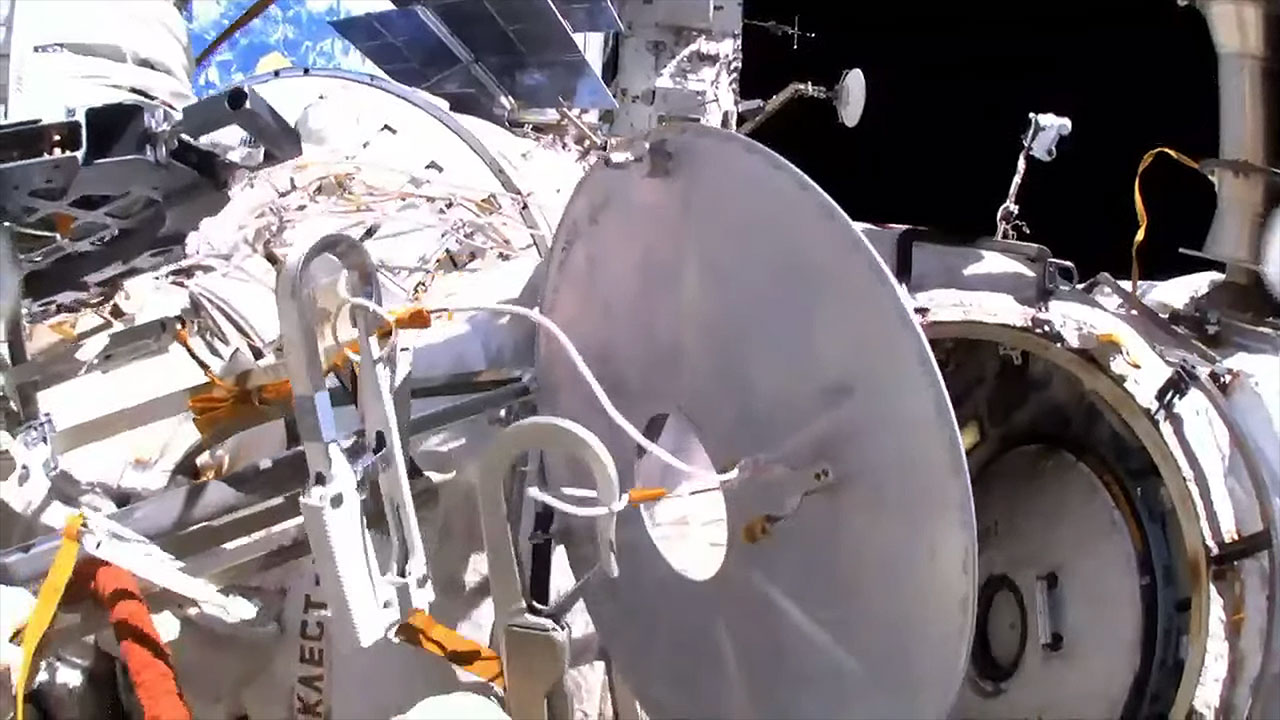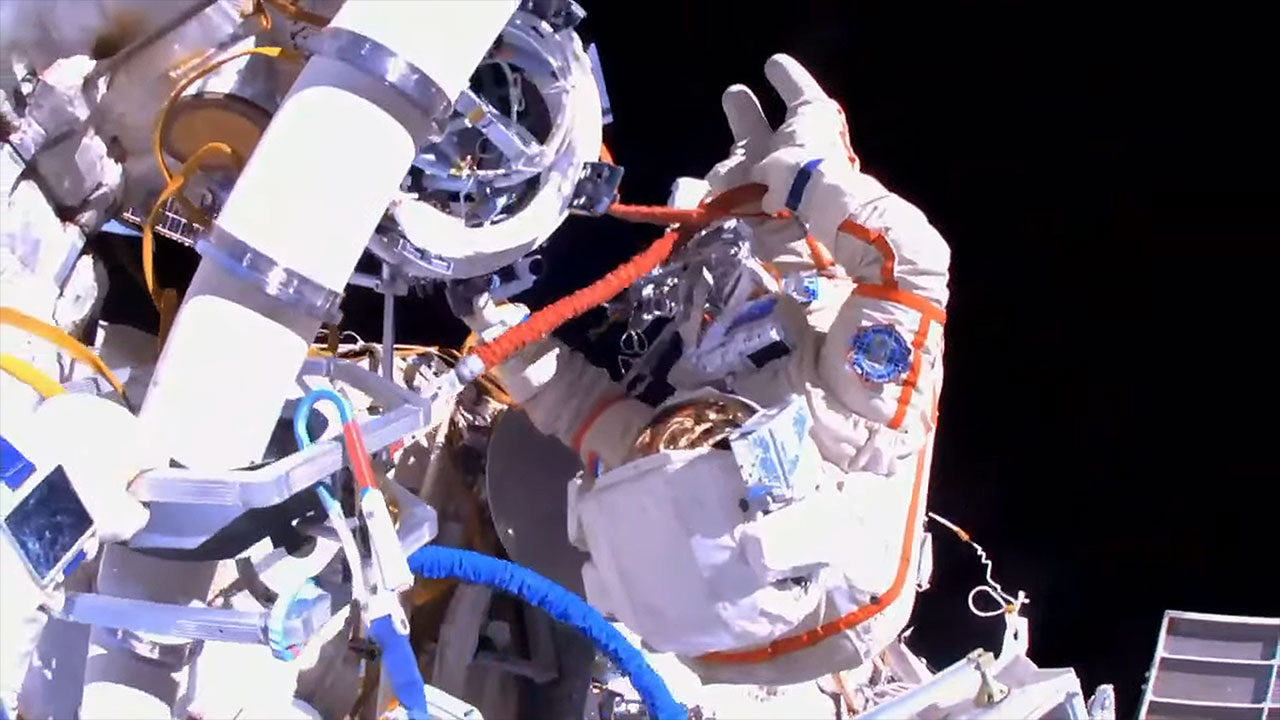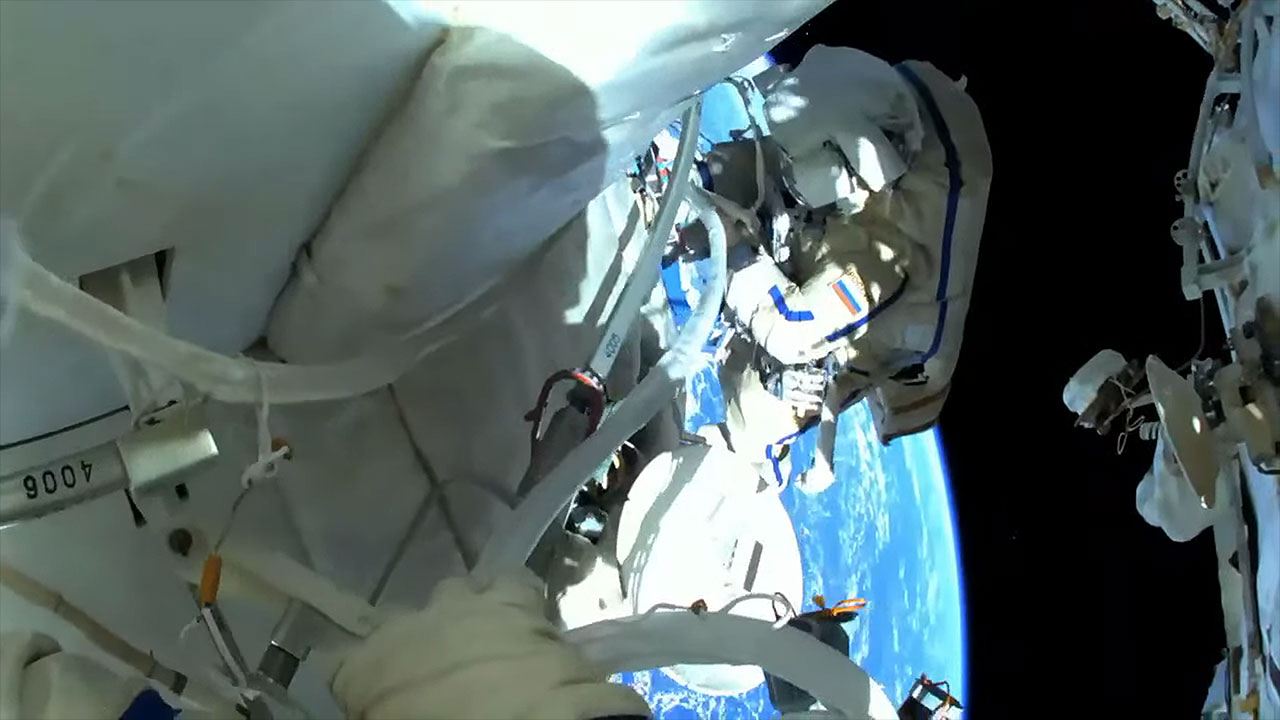Cosmonauts outfit new science module on 50th planned Russian spacewalk outside space station
'And that's where the flying saucer legends come from.'
Two cosmonauts continued the outfitting of a new module outside the International Space Station on what was the 50th planned spacewalk to originate from the Russian segment of the orbiting outpost.
For the second time in seven days, Expedition 65 flight engineers Oleg Novitskiy and Pyotr Dubrov, both of the Russian federal space corporation Roscosmos, donned Orlan spacesuits and exited the Poisk airlock at 10:51 a.m. EDT (1451 GMT) on Thursday (Sept. 9) to begin routing cables for the new multipurpose laboratory module (MLM), or "Nauka" ("Science").
Picking up where they left off at the end of their spacewalk on Sept. 3, Novitskiy and Dubrov photographed the antennas on a Progress cargo craft docked to the space station, installed four handrails to ease maneuvers on future spacewalks and routed an ethernet cable to enable data to run from the U.S. operating segment to experiments on the outside of the new module.
Related: Tour Russia's new Nauka space station module with these astronaut home movies

Although the ethernet cable was successfully mated, Novitskiy and Dubrov ran into some difficulty with the cable reel's flat circular lid. Once the cover was freed from the cable, there was a brief debate about whether to jettison it as originally planned or tie it down to the exterior of the module.
"This shape is sort of tricky," one of the spacewalkers said. "Such an amazing item."
"And that's where the flying saucer legends come from," the cosmonaut joked.
Get the Space.com Newsletter
Breaking space news, the latest updates on rocket launches, skywatching events and more!
A decision was made to temporarily stow the disc and then jettison it with other reuse at the end of the spacewalk.

Novitskiy and Dubrov then moved on to running additional cable bundles, this time to connect the TV systems and data lines between the Nauka the Zvezda service modules, as well as one linking up the automated docking systems for future visiting Russian spacecraft, including the Progress and crewed Soyuz vehicles.
The two cosmonauts then deployed two bio-risk containers that will obtain data on any physical or genetic changes to bacteria, fungi and other microorganisms after being exposed to the vacuum of space. The experiment is focused on better understanding contaminants that could be a factor on interplanetary spacecraft.

Novitskiy and Dubrov wrapped up their spacewalk by jettisoning the ethernet cable reel cover and a piece of multi-layer insulation also removed during the spacewalk. The 7-hour, 25-minute spacewalk ended at 6:16 p.m. EDT (2216 GMT), as the airlock hatch on the Poisk module was closed.
Autonomously docked to the space station on July 29, the Nauka MLM will provide Russian cosmonauts with an expanded area to conduct science and will serve as a docking port and airlock for Russian spacewalks. The module will also house an additional crew quarters and a third toilet for the station's residents.

Thursday's spacewalk was the third for both Novitskiy and Dubrov. Novitskiy was designated extravehicular crew member 1 (EV1) and wore the Russian Orlan spacesuit with red stripes. Dubrov, as EV2, wore a spacesuit with blue stripes.
This was Russia's 50th planned spacewalk and 58th overall conducted using Orlan spacesuits outside of the International Space Station. In total, astronauts and cosmonauts have performed 243 extravehicular activities (EVA) in support of the assembly and maintenance of the orbiting laboratory.
Robert Pearlman is a Space.com contributing writer and the editor of collectSPACE.com, a Space.com partner site and the leading space history news publication. Follow collectSPACE on Facebook and on Twitter at @collectSPACE. Follow us @Spacedotcom and Facebook.
Join our Space Forums to keep talking space on the latest missions, night sky and more! And if you have a news tip, correction or comment, let us know at: community@space.com.

Robert Pearlman is a space historian, journalist and the founder and editor of collectSPACE.com, a daily news publication and community devoted to space history with a particular focus on how and where space exploration intersects with pop culture. Pearlman is also a contributing writer for Space.com and co-author of "Space Stations: The Art, Science, and Reality of Working in Space” published by Smithsonian Books in 2018.In 2009, he was inducted into the U.S. Space Camp Hall of Fame in Huntsville, Alabama. In 2021, he was honored by the American Astronautical Society with the Ordway Award for Sustained Excellence in Spaceflight History. In 2023, the National Space Club Florida Committee recognized Pearlman with the Kolcum News and Communications Award for excellence in telling the space story along the Space Coast and throughout the world.










